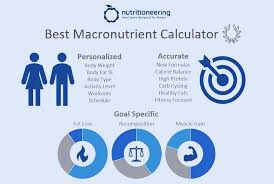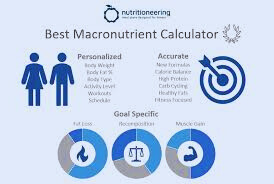Introduction:
In the quest for fitness and overall well-being, understanding the role of nutrition is paramount. While many individuals focus on exercise routines, the significance of a balanced diet cannot be overstated. Macronutrients, including protein, carbohydrates, and fats, are essential components of any dietary plan. However, determining the optimal intake of these macronutrients can be challenging. This is where macronutrient calculators come into play, providing personalized recommendations tailored to individual goals and lifestyles. In this article, we explore the fundamentals of macronutrients, delve into the functionality of macronutrient calculators, and provide practical insights into maximizing fitness results through strategic nutritional planning.

The Basics of Macronutrients:
- Protein: Protein is often hailed as the building block of muscle tissue and is essential for muscle repair and growth. Additionally, it plays a crucial role in various physiological processes, including hormone production and immune function. Sources of protein include lean meats, poultry, fish, eggs, dairy products, legumes, and plant-based proteins such as tofu and tempeh.
- Carbohydrates: Carbohydrates serve as the primary energy source for the body, particularly during high-intensity activities. They are broken down into glucose, which fuels cellular functions and sustains physical performance. While carbohydrates have been subjected to scrutiny in certain dietary trends, they are vital for replenishing glycogen stores and supporting overall health. Whole grains, fruits, vegetables, and legumes are excellent sources of carbohydrates.
- Fats: Despite misconceptions surrounding fats, they are essential for various physiological functions, including hormone synthesis, nutrient absorption, and insulation. Healthy fats, such as those found in avocados, nuts, seeds, olive oil, and fatty fish, should be included in a balanced diet to support cognitive function and promote overall well-being.
Understanding Macronutrient Calculator Ratios:
The optimal distribution of macronutrient Calculator in one’s diet depends on individual goals, activity levels, and metabolic factors. While there is no one-size-fits-all approach, several common macronutrient ratios cater to specific objectives:
- Balanced Ratio: A balanced macronutrient ratio typically consists of approximately 30% protein, 40% carbohydrates, and 30% fats. This ratio provides a moderate intake of each macronutrient, suitable for individuals seeking overall health maintenance and balanced energy levels.
- High-Protein Ratio: For individuals focusing on muscle building and recovery, a higher protein intake may be beneficial. A high-protein macronutrient ratio typically consists of around 40% protein, 30% carbohydrates, and 30% fats. This ratio supports muscle protein synthesis and aids in muscle repair and growth.
- Low-Carb Ratio: Those following a low-carbohydrate diet, such as the ketogenic diet, may opt for a macronutrient ratio that prioritizes fats over carbohydrates. A low-carb ratio typically consists of approximately 40% fats, 30% protein, and 30% carbohydrates. This ratio aims to induce ketosis, a metabolic state where the body utilizes fat as its primary fuel source.
The Functionality of Macronutrient Calculators:
Macronutrient calculators simplify the process of determining personalized macronutrient recommendations based on individual factors such as age, weight, height, activity level, and fitness goals. These calculators utilize mathematical algorithms to generate precise macronutrient targets tailored to specific objectives. Here’s how macronutrient calculators typically work:
- Inputting Personal Data: Users are prompted to input personal information such as age, gender, weight, height, and activity level into the macronutrient calculator. This data serves as the foundation for generating personalized recommendations.
- Selecting Fitness Goals: Users specify their fitness goals, whether it’s fat loss, muscle gain, weight maintenance, or athletic performance enhancement. This information helps the calculator determine the appropriate macronutrient ratios to support these objectives.
- Generating Macronutrient Calculator Targets: Based on the input data and selected goals, the macronutrient calculator computes personalized macronutrient targets for protein, carbohydrates, and fats. These targets are typically expressed in grams per day or as a percentage of total caloric intake.
- Fine-Tuning Recommendations: Some macronutrient calculators allow for additional customization, such as adjusting macronutrient ratios or calorie targets. Users can fine-tune their recommendations based on preferences, dietary restrictions, or specific nutritional approaches.
Practical Tips for Using Macronutrient Calculators:
While macronutrient calculators offer valuable guidance, maximizing their effectiveness requires strategic implementation and ongoing adjustments. Here are some practical tips for using macronutrient calculators effectively:
- Set Realistic Goals: Before using a macronutrient calculator, establish clear and achievable fitness goals. Whether it’s losing body fat, gaining muscle mass, or improving athletic performance, defining specific objectives provides a roadmap for tailoring macronutrient intake accordingly.
- Be Accurate with Data Input: Ensure the accuracy of input data when using a macronutrient calculator. Provide precise information regarding age, weight, height, activity level, and fitness goals to generate personalized recommendations.
- Monitor Progress and Adjustments: Regularly monitor changes in body composition, performance, and overall well-being while adhering to macronutrient targets. Adjust macronutrient ratios or calorie intake as needed based on progress and feedback from your body.
- Prioritize Whole Foods: While macronutrient targets are important, focus on consuming nutrient-dense, whole foods to support overall health and well-being. Emphasize lean proteins, complex carbohydrates, and healthy fats from sources such as fruits, vegetables, lean meats, nuts, seeds, and whole grains.
- Seek Professional Guidance: Consider consulting with a registered dietitian or nutritionist for personalized advice and support. These professionals can offer tailored recommendations, address specific dietary concerns, and provide guidance on optimizing macronutrient intake for your individual needs.
Conclusion:
Macronutrient calculators serve as valuable tools in optimizing dietary planning for fitness and overall well-being. By understanding the basics of macronutrients, utilizing macronutrient calculators effectively, and implementing sound nutritional strategies, individuals can maximize fitness results and achieve their goals more efficiently. Whether you’re aiming to build muscle, lose fat, or enhance athletic performance, harnessing the power of macronutrient calculators empowers you to take control of your nutrition and unlock your full potential. Embrace strategic macronutrient planning as a cornerstone of your fitness journey, and watch as you progress toward a healthier, stronger, and more vibrant self.





